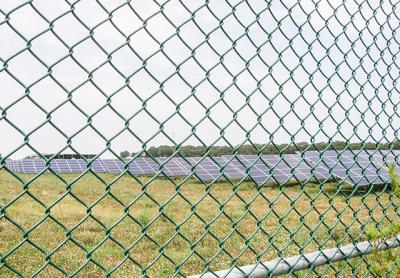Nature Notes: Paddling Up the Wrong Stream

Sunday was the last in a string of hot, rainless days. I took my grandson over to the North Fork to look at the Penny family grave site on Factory Avenue in Mattituck. On the way I visited Calverton because Fred Havemeyer, who is running for supervisor in Southampton Town, told me about a large solar farm on Edwards Avenue in Riverhead, not far from the border of Brookhaven.
After going up and down and back and forth for several minutes past sod farms and vegetable farms, we found it on the east side of the road, across from another Hampton Jitney bus depot, address 194 Edwards Road. We couldn’t go inside; there was no one there, but we were able to take pictures and explore the scene through a sturdy chain-link fence. Two signs on the gated and locked entrance doors read Sutter Greenworks Solar and Sterling Greenworks Solar, with a big SOLV on the bottom of each.
We went to the south end of the array and there we found a sizable PSEG grid. How convenient. Which came first? But we were both in awe of the hundreds and hundreds of black solar panels, side by side, row after row, all mounted on their stands at a 45-degree angle, all facing south, about 40 acres of them. Neither of us had ever seen a large solar farm before. From sod farm to solar farm, not a bad tradeoff, considering that in northwestern Riverhead there are enough sod farms to supply all of the lawn needs for a big city and on both the North and South Forks, lawns are on their way out.
It turns out those panels will produce nearly 12.1 kilowatt hours a year, enough electricity to supply all the needs of 1,116 average-size houses, according to one estimate. What’s even more exciting is that neighboring Brookhaven Town is working on a plan to install enough solar panels on its Calabro town airport to generate up to 21.3 gigawatt hours of electricity, enough to supply 1,378 average-size homes for an entire year.
I did some homework and discovered that East Hampton Airport is 378 acres. If you installed solar panels on 32 acres of it, those acres could produce enough energy to power 1,000 homes over the course of a year.
But wait you say, the Federal Aviation Administration that has given the town so much money but so much trouble over the years would never go for it. Not so. Many airports throughout the United States, both privately and publicly owned, have working solar farms. Perhaps the largest of them is at Indianapolis Airport and has been generating electricity since before 2016. It covers 183 acres and produces enough electricity to power 2,595 homes. Those 87,478 solar panels certainly required F.A.A. approval.
In 2014 East Hampton’s energy sustainability committee came up with a plan to solarize three different sites in the town, the old Bull Path dump, the landfill on Springs-Fireplace Road, and the airport.
How many solar panels have been installed on these sites thus far? As far as I can tell, none. Now there is a plan to put a satellite fire station at the brush dump. If you look around the rest of East Hampton you will find several other sites that have potential. And it turns out that growth in the form of grass or groundcover is not necessarily incompatible with solar panels. The panels can be arranged to accommodate both vegetation and electricity production.
There is a larger airport with more space for solarization in western Southampton Town. It is called Gabreski airport. In 2014 the Suffolk County Legislature floated a plan to solarize part of Gabreski, yet to date, nothing has been done. If you visit the H.L. Dennison Building in Hauppauge, the real “seat” of Suffolk County, you will find solar panels over many of the parking spaces, and the same kind of arrangement over much of the parking lot for Suffolk’s Cohalan court complex in Islip. Such sustainability improvements were made during former County Executive Steve Levy’s administration.
The county has numerous large buildings and barren open spaces on which to install solar panels, but it would seem that the present administration is more concerned at this juncture with other equally outdoorsy projects such as bike shares and the like. The much-maligned PSEG advertises a program of no-money-down solarization for home owners. If left to its own devices and let out from under the governor’s thumb, I would bet that PSEG would push solar and we would see real progress made.
It’s beginning to look as though the biggies that do the heavy lifting for the state and Long Island, in particular, are letting solar slip aside in favor of another non-carbon generating way of generating electricity, using the wind, but at a tremendous startup expense, because they are locating the wind generators on expensive steel poles dug well into the bottom sediments in the ocean offshore. No matter that the power lines running from them have to travel several miles underground to reach shore so that the power they produce can be dumped onto the grid, and then to the homes and businesses.
As one of the fathers of electrification, Thomas Edison, so well pointed out more than 100 years ago, there are very few sunless days in a year, but many more windless days. Seems like we are paddling up the wrong sustainability stream, at least to me it does.
Larry Penny can be reached via email at [email protected].
